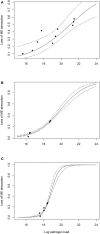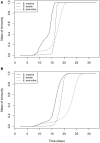Revisiting the Economic Impacts of Eimeria and Its Control in European Intensive Broiler Systems With a Recursive Modeling Approach
- PMID: 33251254
- PMCID: PMC7674784
- DOI: 10.3389/fvets.2020.558182
Revisiting the Economic Impacts of Eimeria and Its Control in European Intensive Broiler Systems With a Recursive Modeling Approach
Abstract
Ionophore compounds active against Eimeria species are widely used in intensive broiler systems and have formed the backbone of coccidiosis control for almost 50 years. Producers, however, are under pressure to reduce ionophore use due to consumer concerns over antimicrobial usage in food animals, and antimicrobial resistance. Moreover, current vaccines against Eimeria are commonly considered to be less cost-effective in intensive broiler systems, especially in Europe where attenuated live vaccines are used. An economic assessment of the impact of Eimeria and the disease coccidiosis, including the cost implications of different efficacies of control, is therefore timely to provide evidence for industry and policy development. A mechanistic model of broiler production under varying infection and control states was used to construct a dataset from which system productivity can be measured. Coccidiosis impact increased rapidly as control efficacy decreased. In the total absence of control, median impact was found to maximize at between €2.55 and €2.97 in lost production per meter squared of broiler house over a 33 day growing period. Coccidiosis remains a major risk to intensive broiler systems and the model developed allows investigation of issues related to coccidiosis control, antimicrobial use and the development of antimicrobial resistance.
Keywords: Eimeria; broiler; coccidiosis; disease control; economics; impact; model.
Copyright © 2020 Gilbert, Bellet, Blake, Tomley and Rushton.
Figures







Similar articles
-
Vaccination with transgenic Eimeria tenella expressing Eimeria maxima AMA1 and IMP1 confers partial protection against high-level E. maxima challenge in a broiler model of coccidiosis.Parasit Vectors. 2020 Jul 10;13(1):343. doi: 10.1186/s13071-020-04210-2. Parasit Vectors. 2020. PMID: 32650837 Free PMC article.
-
Eimeria Oocyst Concentrations and Species Composition in Litter from Commercial Broiler Farms During Anticoccidial Drug or Live Eimeria Oocyst Vaccine Control Programs.Avian Dis. 2017 Jun;61(2):214-220. doi: 10.1637/11578-010317-Reg.1. Avian Dis. 2017. PMID: 28665719
-
Control of eight predominant Eimeria spp. involved in economic coccidiosis of broiler chicken by a chemically characterized essential oil.J Appl Microbiol. 2015 Mar;118(3):583-91. doi: 10.1111/jam.12731. Epub 2015 Jan 14. J Appl Microbiol. 2015. PMID: 25529022 Clinical Trial.
-
Vaccines against chicken coccidiosis with particular reference to previous decade: progress, challenges, and opportunities.Parasitol Res. 2022 Oct;121(10):2749-2763. doi: 10.1007/s00436-022-07612-6. Epub 2022 Aug 4. Parasitol Res. 2022. PMID: 35925452 Free PMC article. Review.
-
Control of coccidiosis in chickens by vaccination.Vet Parasitol. 2001 Sep 12;100(1-2):13-20. doi: 10.1016/s0304-4017(01)00479-4. Vet Parasitol. 2001. PMID: 11522402 Review.
Cited by
-
Benzophenones-natural metabolites with great Hopes in drug discovery: structures, occurrence, bioactivities, and biosynthesis.RSC Adv. 2023 Aug 4;13(34):23472-23498. doi: 10.1039/d3ra02788k. eCollection 2023 Aug 4. RSC Adv. 2023. PMID: 37546221 Free PMC article. Review.
-
Re-calculating the cost of coccidiosis in chickens.Vet Res. 2020 Sep 14;51(1):115. doi: 10.1186/s13567-020-00837-2. Vet Res. 2020. PMID: 32928271 Free PMC article.
-
Use of Zinc Oxide Nanoparticles as Anticoccidial Agents in Broiler Chickens along with Its Impact on Growth Performance, Antioxidant Status and Hematobiochemical Profile.Life (Basel). 2022 Jan 5;12(1):74. doi: 10.3390/life12010074. Life (Basel). 2022. PMID: 35054467 Free PMC article.
-
Forward Genetics in Apicomplexa Biology: The Host Side of the Story.Front Cell Infect Microbiol. 2022 May 12;12:878475. doi: 10.3389/fcimb.2022.878475. eCollection 2022. Front Cell Infect Microbiol. 2022. PMID: 35646724 Free PMC article. Review.
-
A Novel Whole Yeast-Based Subunit Oral Vaccine Against Eimeria tenella in Chickens.Front Immunol. 2022 Feb 2;13:809711. doi: 10.3389/fimmu.2022.809711. eCollection 2022. Front Immunol. 2022. PMID: 35185896 Free PMC article.
References
-
- Haug A, Gjevre A-G, Thebo P, Mattsson JG, Kaldhusdal M. Coccidial infections in commercial broilers: epidemiological aspects and comparison of Eimeria species identification by morphometric and polymerase chain reaction techniques. Avian Pathol. (2008) 37:161–70. 10.1080/03079450801915130 - DOI - PubMed
LinkOut - more resources
Full Text Sources

